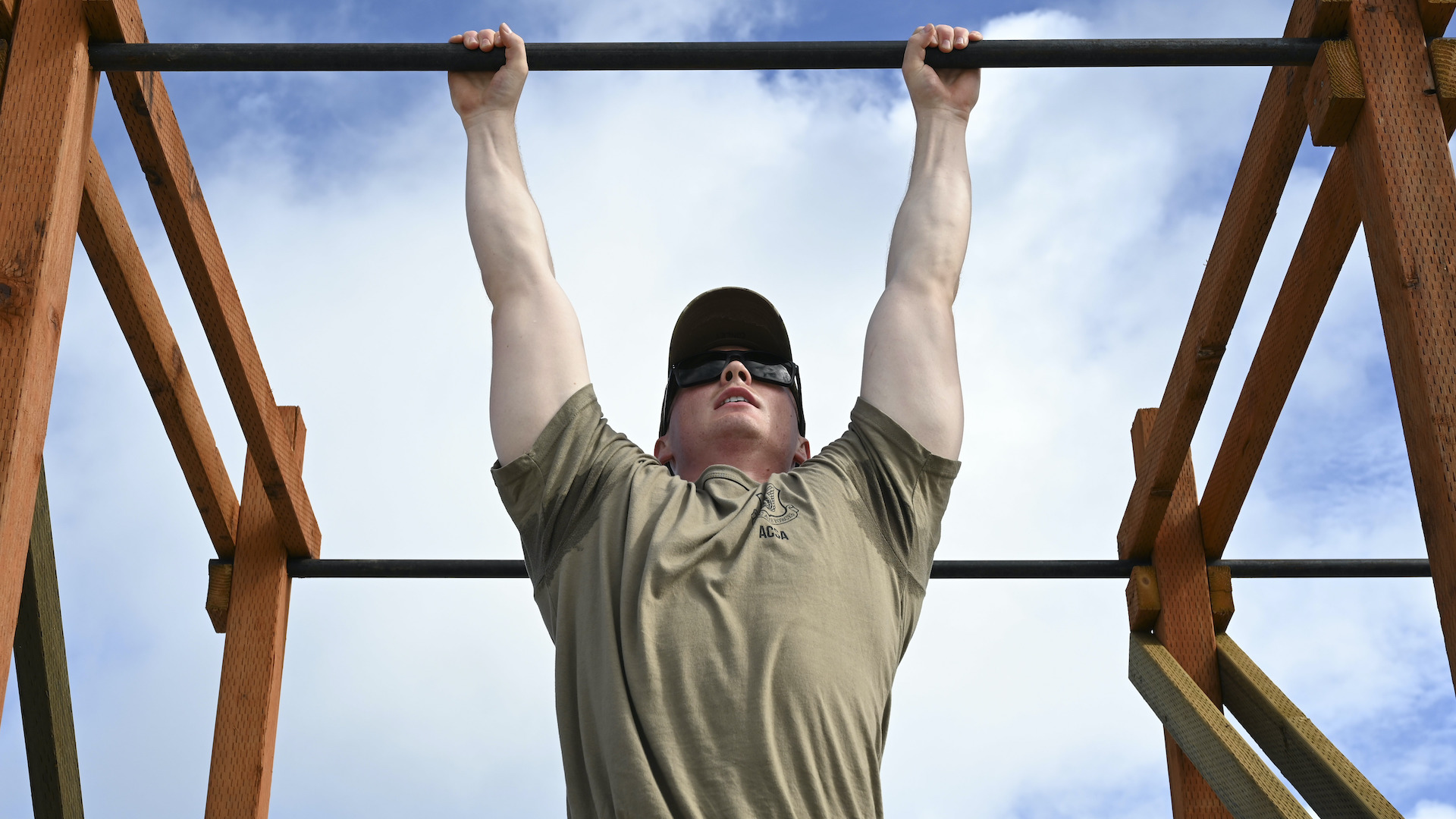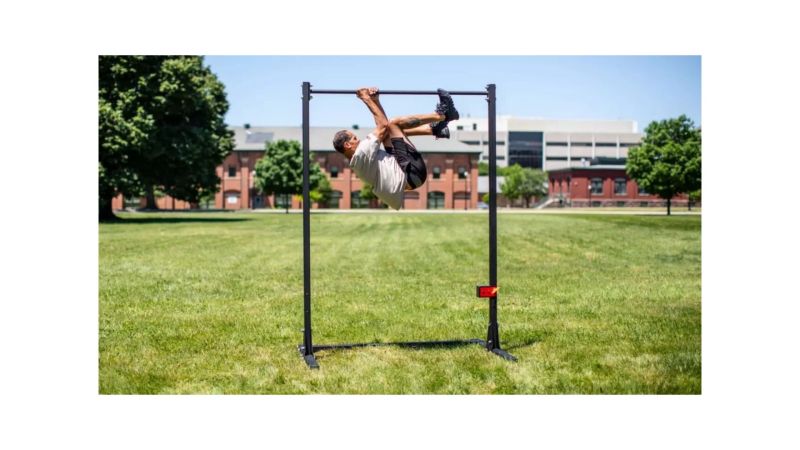We may earn revenue from the products available on this page and participate in affiliate programs.

Obviously, the best pull-up bar is the one on base. It’s the one that’s way too tall, gives you splinters when you touch the posts, and burns your hands if you touch the bare metal bar. To prevent that, we wrap cheap athletic tape around the bar and don’t replace it nearly enough. It’s stained with sweat, blood, and whatever comes out of blisters when they pop. That’s our heritage; that’s how the military tradition is passed from one person to another.
That’s not the only pull-up bar, though. I’m willing to bet that what you’re looking for is the best pull-up bar for home workouts; one that doesn’t require you to hit the gym or find a local park. In that case, I took the liberty of researching some of the brands to choose from and the various ways you can attach a pull-up bar so it can support your weight without causing damage to your home.
By the end of this buying guide, you’ll have the information you need to make an informed decision and pick the best pull-up bar for you. You’ll be on the path to daily pull-up workouts and triumphant fitness tests. Let’s not waste any time, then.
- Best Overall: Rogue P-5V Pull-Up System
- Best Value: Pure Fitness Doorway Pull-Up Bar
- Honorable Mention: EliteFTS Garage Power Rack
- Best Doorway: Rogue Jammer Pull-Up Bar
- Best Free-Standing: Rogue MIL Pull-Up Station
Methodology
The search for this gear guide started by considering the various types of pull-up bars: wall- or ceiling-mounted, doorway, and free-standing. I considered prices as low as $20 and as high as $1,000. A lot of the pull-up bars on the market are made from cheap metal by people who have presumably never done a pull-up, so I narrowed my search by eliminating products that clearly aren’t cut out for serious workouts. Within each category, I picked the pull-up bars I’d be most likely to buy for home gyms with varying budgets, giving priority to the brands I know and trust.
Best Overall
Rogue P-5V Pull-Up System
Best Value
Pure Fitness Doorway Pull-Up Bar
Honorable Mention
EliteFTS Garage Power Rack
Best Doorway
Rogue Jammer Pull-Up Bar
Best Free-Standing
Rogue MIL Pull-Up Station
Our verdict on pull-up bars
The secure, space-efficient Rogue P-5V Pull-Up System is perfect for home and garage gyms. If you want a less expensive option that doesn’t involve drilling, go for the Pure Fitness Doorway Pull-Up Bar.
What to consider when buying a pull-up bar
Since pull-up bars come in a wide range of styles, you need to do some homework to make an informed purchase. There’s also a huge amount of trash out there — most of the pull-up bars you’ll see online are products I wouldn’t go anywhere near. Your primary considerations should be how you like to perform pull-ups and what kind of mounting options are available to you.
Types of pull-up bars
Free-standing
Free-standing pull-up bars are what you see on military installations around the world. You could make one just like them with a pair of pressure-treated four-by-fours and a metal pipe, but there are easier ways to get your pull-up workout in. Metal free-standing pull-up bars like the Rogue MIL Pull-Up Station are also a more efficient use of space because they can be moved when you aren’t working out.
Another kind of free-standing pull-up bar is what you see on power racks at the gym. If you’re ready to make a big investment in your fitness and have the space to do it, power racks provide the best pull-up bars for home gyms. Along with the bar, you’ll get a rack that can handle the squat, bench press, overhead press, and all kinds of other lifts with the addition of a bench and barbell. Add some protection to the floor, and you can add the deadlift and Olympic lifts to that list.
Wall- or ceiling-mounted
Another popular option for more permanent home gyms is mounting your pull-up bar to a wall or ceiling. Both approaches can be more than capable of supporting your weight as long as you use the right hardware and appropriate mounting points. If you’re working with concrete or cinder block walls, you can be pretty flexible with your pull-up bar placement. If you have drywall over studs or joists, you’ll have to tap into the wooden structure of your home to get enough strength for a pull-up bar. This kind of installation isn’t difficult or complicated, you just have to plan ahead.
One way to beef up your walls is to screw wide boards (think two-by-sixes or larger) into your studs and then bolt the pull-up bar to the boards. Whichever pull-up bar you choose will come with installation instructions. Make sure to read them thoroughly and don’t be afraid to ask someone for clarification or run to the hardware store for more tools — taking a little more time on the installation is easier and cheaper than fixing a mistake.
Doorway-mounted
The best pull-up bars for home workouts in the barracks or an apartment are doorway pull-up bars. These bars fit into an open doorway and apply pressure to the frame from both sides using your bodyweight. They aren’t as secure as the other two styles, but they’re much cheaper and don’t require any tools. This style is great for knocking out a few pull-ups in the morning and evening to compliment your existing fitness routine.
One exception is the Rogue Jammer Pull-Up Bar. The Jammer sits close to the wall so you need a doorway to get under it, but it mounts to the wall itself. The result is a strong wall-mounted pull-up bar that doesn’t take up very much space.
Key features of a pull-up bar
Mounting system
The most important aspect of your pull-up bar is how it’s supported. With the exception of doorway pull-up bars that use your body weight to apply force to a door frame, most pull-up bars will need to be screwed into a wall or ceiling. Drywall can’t handle that kind of stress, so you’ll need to find studs in the wall or ceiling joists in your ceiling unless you’re working with a concrete or cinder block wall. Take installation seriously; you’re one wrong move away from a costly home renovation project if you’re careless.
Some pull-up bars stand on their own. Rogue’s MIL Pull-Up Station is relatively light, small, and very well-built. A power rack like the EliteFTS Garage Power Rack costs more, but it’s a legitimate power rack that can be used for all kinds of strength training. Free-standing options are worth considering if you plan on building a complete home gym.
Grip
Once you’ve determined what kind of pull-up bar will work with your living situation, you can start focusing on grip. Straight bars are the most common. They’re cheap to mass-produce, effective, and allow you to train with the same kind of bar you’ll be expected to use during a fitness test. Straight pull-up bars can be used with your hands facing inward or outward and allow for a range of grip widths. Mix up your grip to challenge your body in different ways and avoid training plateaus.
Some bars are more complex. If you really want to mix up your pull-up workouts, find a bar that offers different angles for wide, narrow, outward, inward, and neutral grips. Added materials and labor make these pull-up bars more expensive, but they’re worth it if you really want to throw the kitchen sink at your workout routine.
Pricing for pull-up bars
The best doorway pull-up bars can cost as little as $20. If you need a temporary place to do occasional pull-ups without drilling into your home or barracks room, that’s a great solution. The other picks on this list cost more — between $140 for a standard pull-up bar and more than $800 for one that’s built into a beginner power rack. About $150 should be a good starting point if you want to do your own search.
Tips and tricks
If you have aspirations of joining the 20-plus pull-up club, the good news is that it’s very attainable and frankly takes a lot less effort than drastically improving your run time. Successfully installing a pull-up bar is also something you can do yourself without much trouble. Here are a few words of advice to grease the skids — feel free to add more in the comments section.
Pull-up tips
- Place your hands wherever works for you. The best grip is the one that you can perform the most reps with.
- Never compromise on form. Nobody wants to hear “zero, zero, zero” while they’re on the bar.
- Add reps with smart, consistent training.
- Check your ego at the door. Find people who are better at pull-ups and work out with them every chance you get.
Pull-up bar installation tips
- Read the manufacturer’s instructions. They know what works and what doesn’t.
- If you live in a multistory building, think about where plumbing and electrical routing might have a reason to reach pull-up bar height and check with the appropriate tool before drilling.
- Use the correct anchors when mounting a pull-up bar to a wall or ceiling.
- You can brace studs or joists with stringers for extra support.
- YouTube videos are a great way to visualize what you need to do and are often more helpful than written instructions.
- It should go without saying, but please use a level.
FAQs about pull-up bars
You’ve got questions, Task & Purpose has answers.
Q: Do pull-up bars damage walls?
A: You can seriously damage your walls by installing a pull-up bar incorrectly. Check your installation manual and invest in helpful tools like a stud finder, drill, and the correct hardware for your specific pull-up bar and mounting surface to avoid any problems.
Q: Do no-screw pull-up bars work?
A: Yes, but some are better than others. Doorway pull-up bars that use leverage to grip the door frame are more secure than bars that press against the inside of the doorway.
Q: Are pull-up bars safe at home?
A: If you buy a quality pull-up bar and install it correctly, you shouldn’t have any problems (unless someone catches you kipping).
Q: Are pull-up bars worth it?
A: Pull-ups are one of the best bodyweight exercises for overall fitness. Even if you don’t go all-in on a home gym, getting your own pull-up bar can be a great way to boost your athletic performance.




